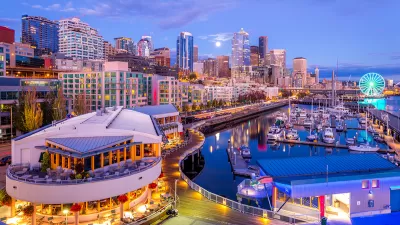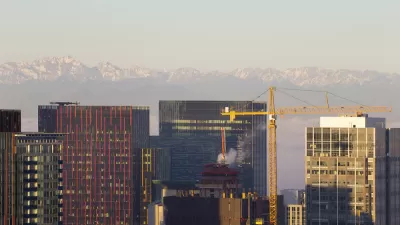In 1851 the City of Seattle could have been a vastly different place if alternative development decisions had been made that took the original inhabitants, nature, and topography into consideration.

Crosscut columnist Knute Berger writes about the development of Seattle from 1851 to the present and how certain development and transportation decisions affected the natural, social, and economic environment.
Berger writes that Seattle "had ambitions to be the new New York, but the retreating ice left us with hills and too little flat land to make a proper port. We needed railroad access, so we filled in the tide flats of what is now SoDo and the Industrial district. We were determined to place grids on a grid-resistant landscape, so we re-graded not just Denny Hill — you know it today as the flats of Belltown, but for years it was simply known as The Regrade....The result, among other things, is a transportation mess that we’ve never built our way out of and aren’t likely to. Think about that when you’re stuck in traffic. Blame the glacier. Blame the founders. Blame the absurdity of their ambition."
Berger suggests that there is something that can be learned from looking back at the development pattern of our urban places. "If those who don’t learn from history are doomed to repeat it, I would posit that those who study the might-have-beens can also learn a great deal too. Re-imaging Seattle’s transformation — the roads not taken (or built) — could be a great tool to think about our future more creatively."
FULL STORY: Rethinking Seattle: What if we could start over?

Alabama: Trump Terminates Settlements for Black Communities Harmed By Raw Sewage
Trump deemed the landmark civil rights agreement “illegal DEI and environmental justice policy.”

Planetizen Federal Action Tracker
A weekly monitor of how Trump’s orders and actions are impacting planners and planning in America.

The 120 Year Old Tiny Home Villages That Sheltered San Francisco’s Earthquake Refugees
More than a century ago, San Francisco mobilized to house thousands of residents displaced by the 1906 earthquake. Could their strategy offer a model for the present?

In Both Crashes and Crime, Public Transportation is Far Safer than Driving
Contrary to popular assumptions, public transportation has far lower crash and crime rates than automobile travel. For safer communities, improve and encourage transit travel.

Report: Zoning Reforms Should Complement Nashville’s Ambitious Transit Plan
Without reform, restrictive zoning codes will limit the impact of the city’s planned transit expansion and could exclude some of the residents who depend on transit the most.

Judge Orders Release of Frozen IRA, IIJA Funding
The decision is a victory for environmental groups who charged that freezing funds for critical infrastructure and disaster response programs caused “real and irreparable harm” to communities.
Urban Design for Planners 1: Software Tools
This six-course series explores essential urban design concepts using open source software and equips planners with the tools they need to participate fully in the urban design process.
Planning for Universal Design
Learn the tools for implementing Universal Design in planning regulations.
Clanton & Associates, Inc.
Jessamine County Fiscal Court
Institute for Housing and Urban Development Studies (IHS)
City of Grandview
Harvard GSD Executive Education
Toledo-Lucas County Plan Commissions
Salt Lake City
NYU Wagner Graduate School of Public Service





























